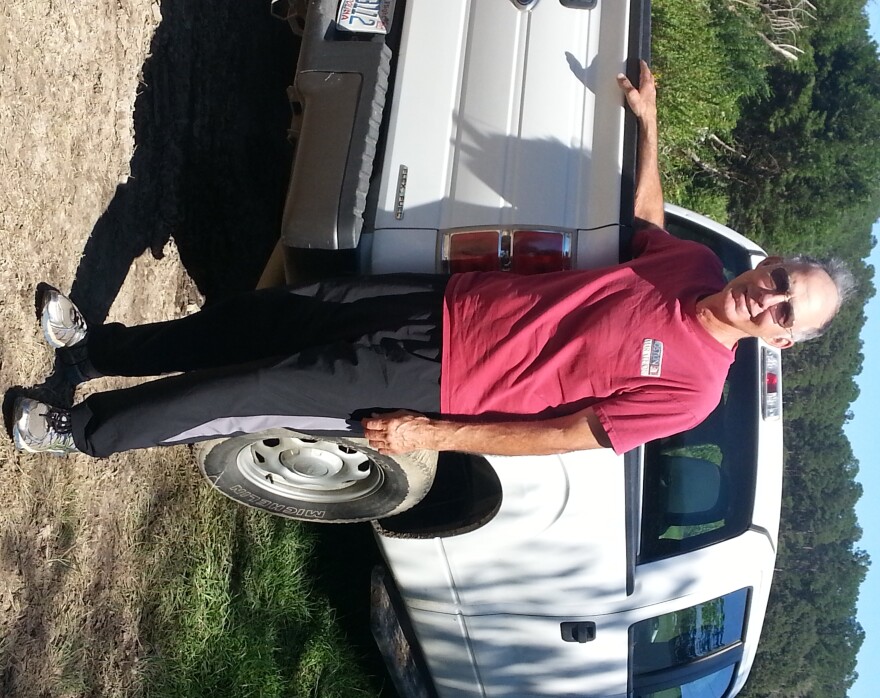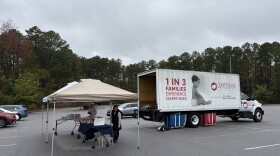Farmers across eastern North Carolina are assessing crop damage following heavy rains and flooding. Some growers have lost entire fields while others will wait weeks to determine what can be harvested. As local and state officials scurry to place a value on what was lost, members of the agriculture community say they’re glad the harm wasn’t worse.
Since 1756, Kelly Holden’s family has been farming a section of land next that today sits next to U.S. 17 near the South Carolina border. The slender 65-year-old man wears glasses and a Boston Marathon t-shirt climbs into his white Ford pick-up truck.
He’s examining sections of the 250 acres where he grows tomatoes, cantaloupes, watermelons, pumpkins and strawberries, among other produce.
"You know those squash are not as bad a shape as I thought they’d be in," he says, pointing out the window, "but the cantaloupes you can go out there and pick them, and just completely tasteless – so there is no point in even picking them."
Holden measured and sixteen and a half inches of rain fell here in less than a week. That’s about four months worth.
"I mean it was pure mush. Today is the first day I’ve been able to put the tractors in."
He says it’s a misconception that produce needs lots of rain.
"Most vegetable farmers, they don’t talk a lot about it because people don’t understand it – that’s the last thing they want is a lot of rain. We would rather put the amount of water the plant needs there. And you always produce a higher quality crop when you have that."
Tomatoes are his most profitable crop - bringing in about 10-thousand dollars per acre. Some of his tomatoes are pick-your-own. Two customers pass by in the back of a tractor.
More than 30 years ago Kelly Holden switched from farming tobacco to produce after Hurricane Diana devastated his crop. He’s been through Hurricanes Hugo, Fran, Floyd and Irene.
"But this year it really wasn’t that bad. I’m thankful we’re not damaged any more than we are."
Holden says he doesn’t do estimates – what’s gone is gone and what he can harvest he will. He also does not have insurance or any interest in government assistance which he says can take more than a year to receive.
"I don’t want any part of it. There’s always too many strings attached in the bureaucracy of it and I just don’t take part in it."

Still, local and state officials are working to make aid available if famers want it. Governor Pat McCrory visited Brunswick County earlier this week.
"It’s probably going to take several days of evaluation. The dilemma we have, form the latest report I got, is just that certain crops are just sitting in the fields rotting right now and they can’t get to the crops to pick ‘em. And we’re right in the prime season to pick ‘em. And we’ve already heard from several farmers who have lost everything – for the year," McCrory said.
After the initial survey, is seems cotton is among the hardest hit crops – a total loss in some areas. Sam Marshall is a horticulture agent with NC State University’s Cooperative Extension program based in Brunswick County. He explains the seeds inside cotton bowls are soft because of all the rain – and that’s bad.
"Because when you’re threshing cotton you need to pull the seeds away from the cotton because what you’re after is the fluffy stuff. You want the seeds away from the gin," Marshall explained.
And if you can’t do that, it’s not harvestable. Marshal says in the days following the storm this is a case-by-case determination. Some plants are not ready for harvest and the extent of damage is not yet known. Take for example sweet potatoes – a root crop.

"What happens is when you have a lot of rain, heavy rain fall, it saturates that soil and you follow that with warm sunny weather, it heats that soil up and in a sense it steams the sweet potatoes and basically causes them to rot out," he said.
Farmers should know more about sweet potato crops in two weeks and the fate of local soybeans by early November.







